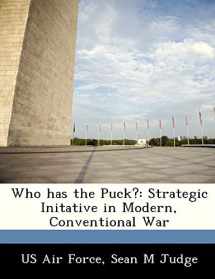
Who Has the Puck?: Strategic Initative in Modern, Conventional War
ISBN-13:
9781249353409
ISBN-10:
1249353408
Author:
Sean M. Judge
Publication date:
2012
Publisher:
Bibliogov
Format:
Paperback
138 pages
FREE US shipping
Book details
ISBN-13:
9781249353409
ISBN-10:
1249353408
Author:
Sean M. Judge
Publication date:
2012
Publisher:
Bibliogov
Format:
Paperback
138 pages
Summary
Who Has the Puck?: Strategic Initative in Modern, Conventional War (ISBN-13: 9781249353409 and ISBN-10: 1249353408), written by authors
Sean M. Judge, was published by Bibliogov in 2012.
With an overall rating of 4.4 stars, it's a notable title among other
books. You can easily purchase or rent Who Has the Puck?: Strategic Initative in Modern, Conventional War (Paperback) from BooksRun,
along with many other new and used
books
and textbooks.
And, if you're looking to sell your copy, our current buyback offer is $0.58.
Description
Historians and other military analysts often use the term "strategic initiative." Most assume a common understanding of this term. But the concept has been neither carefully defined nor examined in depth. This thesis contributes to the elimination of that gap by answering the question, what factors lead to shifts in strategic initiative during the conduct of modern, conventional war? The Russo-German War of 1941-1945 and the Pacific War of 1941-1945 provide the historical evidence for this study. Both conflicts progressed through three distinct phases in which the Axis combatant first seized the strategic initiative, the initiative then fell into dispute, and the initiative eventually shifted to control of the Allied combatant. Four factors contributing to strategic initiative have been examined for each phase of each war: resources, intelligence, strategic acumen, and operational and tactical methods. These elements of military effectiveness reflect each nation's war-making capacity, knowledge, wisdom, and technique. The relative advantages each side enjoyed in each category have been compared to determine which factors more significantly influenced shifts in strategic initiative and how each component acted upon the others. The heart of the study focuses on the transition into, conduct during, and the transition from the second phase of each war, where the actual shifts in initiative occurred. Strategic acumen led the hierarchy of factors that influence strategic initiative in war. The side that better matched its goals with its capabilities, took advantage of opportunities, and planned more realistically reaped the largest rewards. Good intelligence proved to be a key enabler to the clear judgments that are the hallmark of strategic acumen and placed second in the hierarchy. Resources, followed by operational and tactical methods, placed third and fourth respectively. Nevertheless, each of these components influenced the possession of and shifts in strategic ini


We would LOVE it if you could help us and other readers by reviewing the book
Book review

Congratulations! We have received your book review.
{user}
{createdAt}
by {truncated_author}


